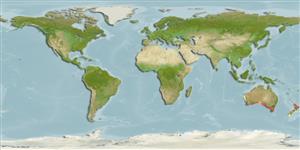Environment: milieu / climate zone / depth range / distribution range
Ecología
marino; salobre demersal; rango de profundidad 1 - 80 m (Ref. 33839). Temperate
Eastern Indian Ocean: southern Australia, from southwestern Australia to New South Wales.
Tamaño / Peso / Age
Maturity: Lm ? range ? - ? cm
Max length : 30.0 cm TL macho / no sexado; (Ref. 9563)
Short description
Morfología | Morfometría
Radios blandos dorsales (total): 76-86; Radios blandos anales: 51 - 56. Body deep (55-60% SL). Snout extended into a hook-like process projecting downwards in front of small, oblique mouth. Scales ctenoid, very small, rather firmly attached on both sides. Pectoral fin rays on right side 11-13, left 9-12. Pelvic fin rays on right side 7, left 4. Caudal fin rays 14 (Ref. 33839).
Occurs in sandy regions of bays and offshore areas. Flesh of very high quality but individuals taken are not often sufficiently large to make preparation worthwhile (Ref. 33839).
Life cycle and mating behavior
Madurez | Reproducción | Puesta | Huevos | Fecundidad | Larva
Gomon, M.F., C.J.M. Glover and R.H. Kuiter (eds.), 1994. The fishes of Australia's south coast. State Print, Adelaide. 992 p. (Ref. 33839)
IUCN Red List Status (Ref. 130435)
Threat to humans
Harmless
Human uses
Pesquerías: comercial
Más información
Age/SizeCrecimientoLength-weightLength-lengthLength-frequenciesMorfometríaMorfologíaLarvaDinámica larvariaReclutamientoAbundanciaBRUVS
ReferenciasAcuiculturaPerfil de acuiculturaRazasGenéticaElectrophoresesheritabilidadEnfermedadesProcesamientoNutrientsMass conversion
Herramientas
Special reports
Download XML
Fuentes de Internet
Estimates based on models
Preferred temperature (Ref.
123201): 15 - 20.4, mean 17.7 °C (based on 206 cells).
Phylogenetic diversity index (Ref.
82804): PD
50 = 0.5312 [Uniqueness, from 0.5 = low to 2.0 = high].
Bayesian length-weight: a=0.01820 (0.00786 - 0.04213), b=2.97 (2.76 - 3.18), in cm total length, based on LWR estimates for this (Sub)family-body shape (Ref.
93245).
Nivel trófico (Ref.
69278): 3.1 ±0.26 se; based on food items.
Resiliencia (Ref.
120179): Alto, población duplicada en un tiempo mínimo inferior a 15 meses (Preliminary K or Fecundity.).
Fishing Vulnerability (Ref.
59153): Low vulnerability (20 of 100).
